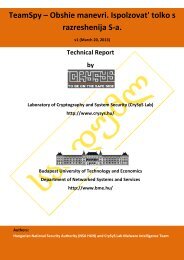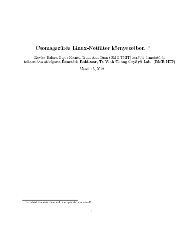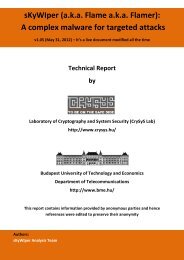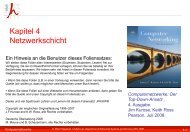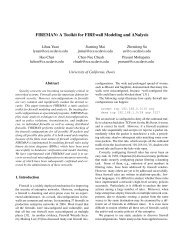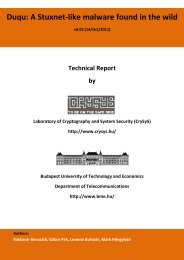You also want an ePaper? Increase the reach of your titles
YUMPU automatically turns print PDFs into web optimized ePapers that Google loves.
3.2. Model of local attacker and mix zone<br />
solution, and in Section 3.7, I present the results of my experiments showing that my approach<br />
does indeed make tracing of vehicles hard for the attacker, and that it is usable in the real world.<br />
Finally, I report on some related work in Section 3.8, and conclude the chapter in Section 3.9.<br />
3.2 Model of local attacker and mix zone<br />
3.2.1 The concept of the mix zone<br />
I consider a continuous part of a road network, such as a whole city or a district of a city. I assume<br />
that the adversary installed some radio receivers at certain points of the road network with which<br />
she can eavesdrop the communications of the vehicles, including their heart beat messages, in a<br />
limited range. On the other hand, outside the range of her radio receivers, the adversary cannot<br />
hear the communications of the vehicles.<br />
Thus, the road network is divided into two distinct regions: the observed zone and the unobserved<br />
zone. Physically, these zones may be scattered, possibly consisting of many observing<br />
spots and a large unobserved area, but logically, the scattered observing spots can be considered<br />
together as a single observed zone. This is illustrated on the left hand side of Figure 3.1.<br />
observation<br />
spots<br />
observed zone<br />
4<br />
1<br />
3<br />
2<br />
6<br />
5<br />
1<br />
mix zone<br />
2 3<br />
Figure 3.1: On the left hand side: The figure illustrates how a road network is divided into<br />
an observed and an unobserved zone in the model. In the figure, the observed zone is grey, and<br />
the unobserved zone is white. The unobserved zone functions as a mix zone, because the vehicles<br />
change pseudonyms and mix within this zone making it difficult for the adversary to track them.<br />
On the right hand side: The figure illustrates how the road network on the left can be abstracted<br />
as single mix zone with six ports.<br />
Note that the vehicles do not know where the adversary installed her radio receivers, or in<br />
other words, when they are in the observed zone. For this reason, we can assume that the vehicles<br />
continuously change their pseudonyms 1 . In this part of the chapter, we can abstract away the<br />
frequency of the pseudonym changes, and we can simply assume that it is high enough so that<br />
every vehicle surely changes pseudonym while in the unobserved zone. I intend to relax this<br />
assumption in my future work.<br />
Since the vehicles change pseudonyms while in the unobserved zone, that zone functions as a<br />
mix zone for vehicles (see the right hand side of Figure 3.1 for illustration). A mix zone [Beresford<br />
and Stajano, 2003; Beresford and Stajano, 2004] is similar to a mix node of a mix network [Chaum,<br />
1981], which changes the encoding and the order of messages in order to make it difficult for the<br />
adversary to link message senders and message receivers. In my case, the mix zone makes it<br />
difficult for the adversary to link the vehicles that emerge from the mix zone to those that entered<br />
it earlier. Thus, the mix zones makes it difficult to track vehicles. On the other hand, based on the<br />
observation that I made in the Introduction, I assume that the adversary can track the physical<br />
location of the vehicles while they are in the observed zone, despite the fact that they may change<br />
pseudonyms in that zone too.<br />
1 Otherwise, if the vehicles knew when they are in the unobserved zone, then it would be sufficient to change their<br />
pseudonyms only once while they are in the unobserved zone.<br />
31<br />
ports<br />
6<br />
5<br />
4



